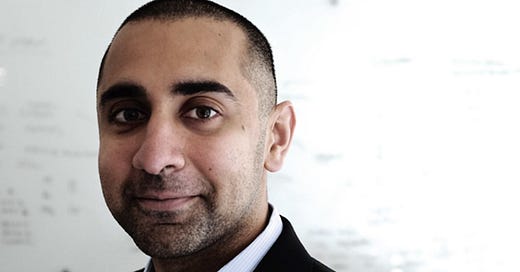

Discover more from American Ambition
Two years ago on January 30, 2020, Balaji Srinavasan tweeted some remarkable predictions:

Now, I had my own pretty good track record on foreseeing our COVID future. I’d predicted we would see 100,000 cases of COVID in March 2020, civil unrest in summer 2020, and did a practice lockdown drill in early March with my company. Doing a practice drill was considered so strange and unusual that the Washington Post sent a reporter to follow me around for the day.
But my crystal ball is a cloudy pebble compared to Balaji’s. His predictions came in early January, even before the coronavirus was named COVID-19. Before the doctor who first warned the world about it had died from the disease. Before we’d seen outbreaks in Europe and the US.
While the rest of us thought Kobe Bryant’s accidental death that week would be the saddest story of the year, Balaji was looking into the future and nailed 7 out of 7 predictions. As a commenter on one of his YouTube videos says, “The more I listen to Balaji the more I’m convinced he’s a time traveler.”
So how did he foresee the future and tweet it for our benefit? I interviewed Balaji – by Twitter DM, of course – and asked him to share his thoughts on his remarkable predictions and what’s happened since.
On what led to making his Jan. 30th predictions:
“I know a bit of history, a bit about current events, and a bit about tech, and put those together to figure out a possible scenario.
“I do this all the time when writing investment memos or advising founders. I'm not saying every one is quite like the coronavirus one, but as an investor predicting the future is kind of my job.”
On how strongly he felt about these predictions:
“I thought that *if* the coronavirus was as important as it might turn out to be, *then* many of these were likely. Some of them were ‘just’ scaled up observations of things that were already happening, e.g., N-95 mask-wearing had been happening in Asia and SF (due to pollution), and some borders had been closed. So there were some precedents, but then you have to figure out what is likely to go from 0.1% traction to 90% traction.”
On what making accurate predictions taught him about society:
“There's more I could say about coronavirus. We're lucky that it will ‘only’ be about 10M dead worldwide, rather than 100M. But we're unlucky that the US establishment vacillates between apathy and panic, between ignoring something and overreacting. And the extent of the US government and media's failure surprised even me. I thought they might pull it together in a crisis, but it's clear that will not happen, and that is informative for future crises.”
The details in his tweet two years ago provide an even better appreciation for his insight:
“For a virus like this, the time to ’overreact’ is now, before it becomes pandemic.
“However, some folks in the US media are acting just like the Chinese state media they claim to deplore -- and minimizing the issue.”
In retrospect, this is spot on. If we were going to overreact, the time to do it was early. It’s worth noting we banned visitors from China the next day, but even so, by then it was probably too late for the USA. A country with an extremely deeply rooted tradition in favor of freedom of movement is not going to adopt the tactics of the Communist Party of China, which actually involved welding people into their apartments!
“Face masks are on the rise due to infection & pollution. Privacy is a third driver.
“Every American man used to wear a hat. Perhaps everyone wears a face mask soon.
“By the way, this does seem weird… but designer face masks [have been] popular in Asia for a while.”
New York City and a few other densely populated areas did in fact adopt face mask usage throughout the pandemic. And while some, like me, only wore generic versions straight from the box, fancy face masks have flourished on the streets of Manhattan.
“Today, only a subset of jobs are feasible with remote work. But if there's a highly contagious and possibly deadly disease out there, that changes everything.
“With robotics & telepresence, a much larger percentage of jobs could become teleoperated.”
Sure enough, as I shared in “The office is closing”, our own data at Ladders shows the percentage of US professional jobs that are remote work growing from approximately 3% at the time of Balaji’s tweet to 18% at the end of last year. I’m predicting it will rise to 25% by the end of 2022, with a long-run guess of 33% of the US workforce being permanently remote.
In our interview, Balaji also warned about his experience with journalists:
“[The experience] confirmed for me that employees of legacy media corporations were not just evil, but stupid. They mocked and belittled something that could have grievously harmed themselves.”
One (now a New York Times tech reporter) mocked him as bubble boy for his warnings. Journalist Sarah Emerson equated criticism of super spreader events in Chinatown or China itself with being racist. (John Lennon watch out! )
Unfortunately, this type of harassment and ignorance are the behavior we can expect from the legacy media. It’s how small-minded people who are trying to conform to the narrow bigotry of their social class often behave.
And yet, Balaji’s an investor, and that keeps him an optimistic. As a final thought, he shared this about the Network State:
“What's the bull case on America? Crypto America.
“There is a new trend at the city and state level - Miami, Wyoming, Texas - of cooperation between technological progressives and positive-sum politicians to build a better future together.
“A better vision is to unify through common interests, not common enemies.
“Crypto America.”
Follow Balaji on Twitter here and sign up for his newsletter here. He can’t promise you round-the-clock accurate predictions, but does cover “Immutable money, infinite frontier, eternal life.” Which seems enough to keep anybody busy predicting, and creating, the future.
And with that optimistic note, thanks for your time this week, Readers!
Let’s grow!
Marc
Follow me on twitter: @cenedella
Subscribe to American Ambition
“An informed patriotism is what we want. Are we doing a good enough job teaching our children what America is and what she represents in the long history of the world? She is a shining city upon a hill.” - Ronald Reagan ~Largest Substack on the Right~











Two points, or nits, depending on your view:
1) "And the extent of the US government and media's failure surprised even me."
How much 'failure' before it becomes logical to consider that it is not failure at all, at least not in how the term is normally defined? The odds of that many people being that wrong for that long are astronomical. Occam's Razor suggests that this campaign was not failure, it was intentional. Govt and media lined up behind a particular message and not only pushed it in the face of contradictory evidence, they also attacked and tried to silence anyone who noticed the disconnect.
2)“[The experience] confirmed for me that employees of legacy media corporations were not just evil, but stupid."
See 1. When you are parroting a line that is not just wrong but also dangerous and can harm people, then you are in the evil "camp. Two respected media journals pulled a "study" because it was essentially made up. And this is the same media that gave us "Russian collusion" for four years.
Long live the truth.
Get out of ignorance.
Man was invited by his Lord to gather and cooperate.